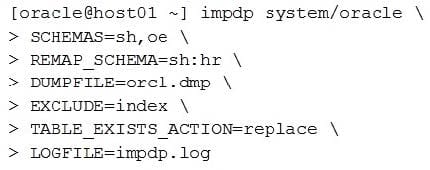1Z0-072 Online Practice Questions and Answers
Which two tasks does DBUA perform by default? (Choose two.)
A. setting user tablespaces to "read only" before starting the upgrade
B. adding more data files if there is insufficient disk space for the SYSTEM tablespace during the upgrade
C. running the Pre-Upgrade information tool
D. starting the source database instance if not started
E. enabling flashback in the source database if not enabled
Which two backup configurations are set by default when you choose Cloud Storage Only as the backup destination? (Choose two.)
A. encryption of backups only for Enterprise Edition databases
B. automatic daily full database backups
C. RMAN incremental backups in a seven-day cycle
D. encryption of backups only for High Performance and Extreme Performance database versions
E. on-demand backups that need to be scheduled
F. encryption for all backups
Which is true about the UNLIMITED TABLESPACE SYSTEM privilege?
A. It can be granted to any user and any role.
B. It is overridden by any specified user space quota.
C. It allows a user to have unlimited space in any tablespace in the database.
D. It allows a user to have unlimited space only in his or her default permanent tablespace.
E. It can be revoked from a user and replaced with a specific space quota only if no user schema objects exist.
Which two are true about the default listener for a single instance database? (Choose two.)
A. It must be defined in the LISTENER.ORA file.
B. It must support at least one service on startup.
C. It must be defined by using the Listener Control utility.
D. It listens on the default port 1521.
E. It uses the settings of the INSTANCE_NAME and SERVICE_NAMES parameters from all databases using that listener.
orcl.dmp contains a full export of the ORCL database.
This command is executed to load data from orcl.dmp into the TESTDB database:

Which two are true? (Choose two.)
A. It skips only tables that exist in both ORCL:SH and TESTDB:HR.
B. It drops and recreates tables that exist in both ORCL:SH and TESTDB:HR.
C. It skips all indexes of ORCL:SH and ORCL:OE.
D. It skips only indexes that exist in both ORCL:SH and TESTDB:HR.
E. It drops and re-creates indexes that exist in both ORCL:SH and TESTDB:HR.
Which three statements are true about an spfile? (Choose three)
A. It contains only static initialization parameters.
B. It is the first file processed at instance startup.
C. It can be edited by SYS when the database instance is shut down.
D. It must exist for a database instance to start.
E. It can be used to create a pfile.
F. It contains initialization parameters whose values can be changed using the ALTER SYSTEM command.
A database is configured to use automatic undo management with temporary undo enabled. An update is executed on a heap-organized table stored in the TBS1 tablespace. Where is the undo stored?
A. in the SYSAUX tablespace
B. in the undo tablespace
C. in the redo logs
D. in rollback segments
E. in the temporary tablespace
In a database, the default temporary tablespace is TEMP and USER1's default tablespace is DATA. Examine these parameters:

Which tablespace stores UNDO generated by USER1's DML on temporary tables?
A. DATA
B. SYSTEM
C. SYSAUX
D. TEMP
E. UNDOTBS1
A user complains about poor database performance. You suspect that the user's session is losing time waiting for events to complete.
You want to verify this.
Which view reveals on what events a session has spent time waiting in the past?
A. V$SESSION_WAIT_CLASS
B. V$SYSTEM_EVENT
C. V$SESSION
D. V$SESSION_EVENT
E. V$SESSION_WAIT
In your database, you want to create a tablespace of non-standard block size by using this command:

Which is a requirement for this command to succeed?
A. All other DB_nK_CACHE_SIZE parameters should be set to zero.
B. The DB_16K_CACHE_SIZE parameter should be set to a value that can be accommodated in the available SGA.
C. The value of the DB_CACHE_SIZE parameter should not be 16 KB.
D. The DB_16K_CACHE_SIZE parameter should be set to a value less than that of DB_CACHE_SIZE.
E. The DB_BLOCK_SIZE parameter must be set to a value greater than 16 KB.
Which is true about unexpired undo?
A. It is required when a transaction rolls back.
B. It may be used to support flashback queries.
C. It consists of undo only for uncommitted transactions.
D. It is always retained for the time specified in UNDO__RETENTION.
E. It is the first type of undo overwritten when trying to avoid out-of-space errors.
Which two are prerequisites for shrinking a table online?
A. It must have a unique key constraint.
B. It must not have any referential integrity constraints.
C. It must not have any DML triggers.
D. It must be in a tablespace that uses Automatic Segment Space Management (ASSM) .
E. It must have row movement enabled.
Which is always true about privileges?
A. Connections as SYSTEM can use only the SYSOPER privilege.
B. Connections as SYS must be made using the SYSDBA privilege
C. System privileges can be granted only to users.
D. The owner of a schema is granted all object privileges within the schema by default.
E. The SYSDBA privilege can be granted to a user or role.
Which is true about roles?
A. A role can be granted to other roles.
B. Roles can be created only by SYS or SYSTEM.
C. Roles containing object privileges can be created only by the object owner.
D. All roles belong to the SYSTEM schema.
E. A role can be password-protected only if it has been granted system privileges.
Which two are true about conventional path SQL load? (Choose two.)
A. It does not generate UNDO.
B. It cannot load data into clustered tables.
C. It locks objects being processed.
D. It enforces referential integrity constraints.
E. It always generates redo.
